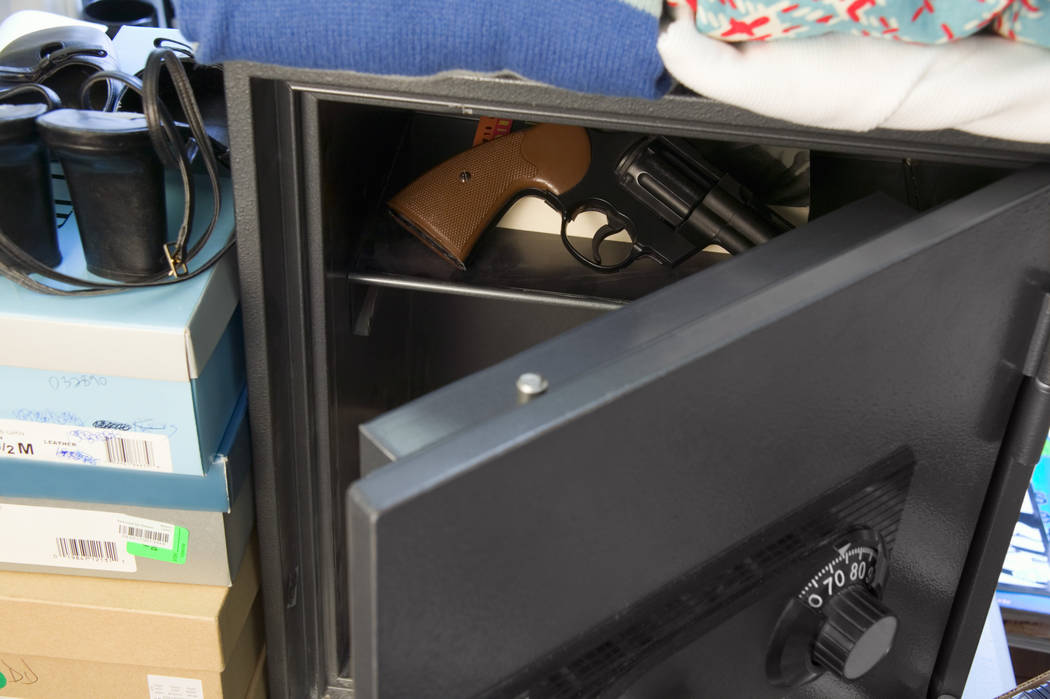In-home safe keeps valuables secure
Home security cameras offer a sense of safety where homeowners believe that someone burglarizing their home will be photographed and possibly arrested in the aftermath of their crime. But criminal research shows that most home burglaries are random, last five minutes or less and are done by teens who are looking for drugs, cash, jewelry or whatever they can grab on their way out the door.
But an in-home safe can deter these would-be criminals who don’t know how to open the safe, maybe not even find it or have the proper tools to dismantle it. Any form of resistance, meaning a safe, is sufficient to stop a burglar.
Marc Montgomery, a salesman at Nevada Safes, knows in-home safes are the smart solution for securing valuables such as jewelry, watches, rare coins, passports, personal documents and family keepsakes.
“I can tell you that in my safe, I have an American flag from my grandfather’s funeral,” he said. “He was a war veteran, and my grandmother gave it to me. You’ll also find my first teddy bear and a plaque with my daughter’s handprint when she was just a toddler.
“So a safe is not just to hold items that have financial worth. It can hold items that are personal, have sentimental value, and important to you and your family. We’re also learning that responsible adults are keeping certain medications in the safe, so those in the household who are taking the medicine do not abuse themselves.”
Montgomery said recent earthquakes in California have spurred sales as homeowners consider safes that can also protect valuables during flooding, fire or other natural disasters.
“First-time buyers usually start with something small but within a year or two come back looking for a larger unit,” he said. “It’s amazing how many customers tell us they end up putting more stuff in their safe than they ever thought possible
“So allow for more space than you think you’ll need. Plan for growth. The fireproof feature of a safe leads people to store documents and other valuables in a space originally intended just for jewelry or maybe a handgun.”
Most of the popular safes are 18 to 24 inches wide. They come in various models and range in general construction. If the safe is be used for documents and personal valuables, Montgomery said, it should be 30 to 42 inches tall and no more than 26 inches wide — about the size of a large end table.
There is no one statistic that determines who buys a safe. Some are victims who were recently robbed and do not want to be caught off guard again. Others are reacting to a police news story they read in the newspaper or saw on television and decide they need to secure their personal items. Others are reacting to a crime that happened to a relative, friend or neighbor and decide that they need a safe.
Montgomery said there is no one place in the home where a safe should go. Its location is usually determined by how often it is going to be opened.
“If a person has a safe solely for personal documents or rare baseball cards, it is not going to be handled on a daily basis,” he said. “Also, this safe is going to have a higher fireproof rating, so it can go into a second bedroom or maybe even the garage. If the safe is going to be opened regularly, then the master bedroom, pantry or a nearby closet is a good location.”
Then there are gun safes. The main reason to own one is to prevent children who are too young to understand gun safety from gaining access to firearms.
There are different “classes” of burglary safes to consider. The ratings are guidelines from a testing agency known as Underwriters Laboratories. UL ratings are based upon specific construction standards and testing thresholds.
Class C rated safes have at least 1 inch of steel door thickness and at least ½ inch of wall thickness all around. They are usually twice as thick and twice as heavy as their Class B counterparts. This class of safe would be sufficient to store small to large valuables.
A safe qualifies as Class B or Class C purely based on its construction.
Some burglars come equipped with tools that can open certain safes. A veteran burglar can see a safe, recognize its brand and know it can be opened with a crowbar, pry bar, sledgehammer or some type of power tool.
TL Ratings are used to rate safes according to their demonstrated resistance to criminal compromise. UL uses a measuring standard called Net Working Time to determine how long it would take a reasonably well-equipped and knowledgeable burglar to compromise a safe.
Fire ratings also are established by UL. A safe with a fire rating of UL Class 350 1-hour for example, will take at least an hour to exceed 350 degrees Fahrenheit when exposed to outside temperatures exceeding 1,700 degrees Fahrenheit.
Safes with fire protection are usually made of sheet metal and are designed to give off moisture during a fire. With that being said, the best items to store in a fire-rated safe are those that will survive moisture, such as valuable papers, cash and jewelry. Items especially not good to be stored in this type of safe would be items such as cameras, stamp collections and guns.
Consider bolting the gun safe to the floor. If you just haul your safe into the house, a thief can haul it out. And spend time determining what type of lock is desired: combination, electronic or biometric. Each has its pros and cons.
An electronic safe is easy to use and can integrate with home security and surveillance systems. But it does require battery changes, and if you forget the combination, a locksmith will have a hard time opening it. The highest reliability exists for mechanical locks.

















